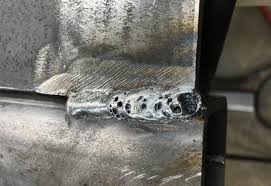What is Porosity in Welding: Best Practices for Avoiding Permeable Welds
What is Porosity in Welding: Best Practices for Avoiding Permeable Welds
Blog Article
Unraveling the Secret of Porosity in Welding: Tips for Reducing Issues and Making Best Use Of Quality
In the complex world of welding, porosity remains a persistent obstacle that can considerably affect the top quality and honesty of bonded joints. As we dig right into the midsts of porosity in welding, uncovering the secrets to its prevention and control will be vital for professionals looking for to master the art of high-quality weldments.
Recognizing Porosity in Welding
Porosity in welding, a common problem experienced by welders, describes the visibility of gas pockets or spaces in the bonded product, which can jeopardize the stability and quality of the weld. These gas pockets are generally entraped throughout the welding process because of various variables such as incorrect securing gas, contaminated base materials, or wrong welding parameters. The formation of porosity can weaken the weld, making it at risk to splitting and corrosion, ultimately causing structural failings.
By recognizing the relevance of preserving proper gas shielding, making certain the sanitation of base products, and enhancing welding settings, welders can dramatically lower the possibility of porosity development. In general, an extensive understanding of porosity in welding is essential for welders to create high-quality and resilient welds.

Usual Root Causes Of Porosity
When checking welding processes for possible quality concerns, recognizing the typical root causes of porosity is crucial for preserving weld stability and protecting against architectural failings. Porosity, defined by the presence of tooth cavities or gaps in the weld metal, can considerably endanger the mechanical residential properties of a bonded joint. One common reason of porosity is incorrect protecting gas coverage. Inadequate protecting gas circulation rates or inappropriate gas mixes can result in climatic contamination, resulting in porosity formation.
In addition, welding at inappropriate specifications, such as exceedingly high travel rates or currents, can create extreme disturbance in the weld pool, capturing gases and triggering porosity. By attending to these typical causes with appropriate gas shielding, product preparation, and adherence to ideal welding criteria, welders can lessen porosity and boost the quality of their welds.
Techniques for Porosity Prevention
Executing effective safety nets is vital in decreasing the occurrence of porosity in welding procedures. One strategy for porosity avoidance visit here is guaranteeing proper cleansing of the base steel prior to welding. Impurities such as oil, oil, rust, and paint can bring about porosity, so detailed cleaning making use of appropriate solvents or mechanical techniques is important.

Making use of top quality filler products and shielding gases that are appropriate for the base steel and welding process can substantially reduce the threat of porosity. Additionally, maintaining correct welding criteria, such as voltage, present, take a trip rate, and gas circulation rate, is vital for porosity prevention.
Furthermore, employing proper welding methods, such as maintaining a constant travel rate, electrode angle, and arc length, can help stop porosity (What is Porosity). Sufficient training navigate to this site of welders to guarantee they follow finest techniques and quality assurance treatments is likewise important in minimizing porosity defects in welding

Finest Practices for Quality Welds
One trick practice is maintaining proper tidiness in the welding area. Extensively cleansing the workpiece and surrounding location prior to welding can help mitigate these problems.
Another best technique is to carefully choose the ideal welding parameters for the details materials being signed up with. Correct criterion choice ensures optimal weld infiltration, combination, and total top quality. Using high-quality welding consumables, such as electrodes and filler metals, can substantially impact the last weld high quality.
Importance of Porosity Control
Porosity control plays an essential duty in making certain the stability and high quality of welding joints. Porosity, identified by the presence of dental caries or gaps within the weld steel, can considerably jeopardize the mechanical residential properties and structural integrity of the weld. Excessive porosity damages the weld, making it more prone to fracturing, deterioration, and general failure under operational lots.
Reliable porosity control is vital for maintaining the desired mechanical residential properties, such as strength, ductility, and strength, of the bonded joint. What is Porosity. By lessening porosity, welders can improve the total quality and dependability of the weld, making sure that it satisfies the efficiency needs of the designated application
Additionally, porosity control is crucial for accomplishing the preferred visual appearance of visit the website the weld. Too much porosity not only compromises the weld however likewise interferes with its aesthetic allure, which can be crucial in markets where aesthetics are very important. Proper porosity control techniques, such as making use of the appropriate protecting gas, regulating the welding specifications, and ensuring proper sanitation of the base materials, are important for generating high-quality welds with minimal flaws.

Verdict
In final thought, porosity in welding is an usual issue that can compromise the high quality of the weld. It is important to regulate porosity in welding to guarantee the integrity and toughness of the final item.
Report this page